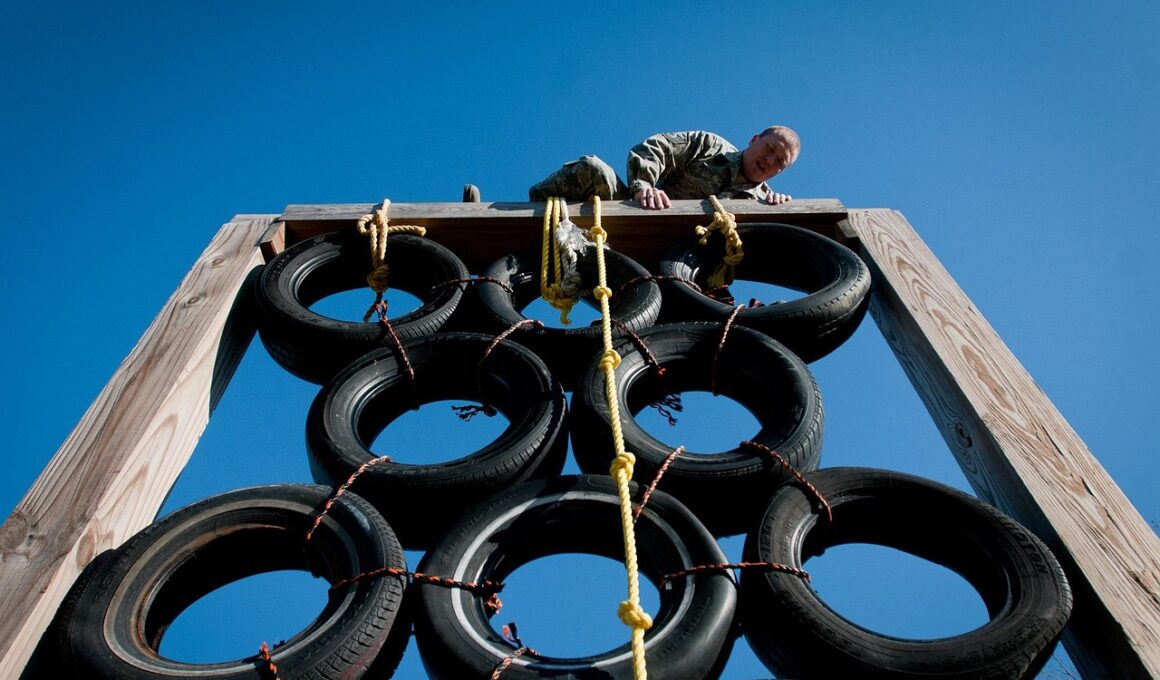Plyometric Training for Enhanced Agility in Obstacle Course Racing
Plyometric training is an essential component of strength and conditioning for obstacle course racing (OCR). This training method enhances an athlete’s ability to execute explosive movements, which is vital for overcoming various physical challenges presented in OCR events. By incorporating drills that focus on rapid muscle contractions, athletes can improve their agility and overall performance on the course. Techniques such as box jumps, depth jumps, and bounding exercises create the necessary conditions for strength development, increased power output, and enhanced coordination. Whether maneuvering through barriers or leaping over obstacles, plyometric training equips OCR competitors with faster reflexes and the ability to change direction swiftly. A structured plyometric regimen should include exercises targeting different muscle groups to achieve well-rounded strength. Additionally, this type of training can be adjusted to fit an athlete’s experience level, ensuring it is beneficial to both beginners and seasoned OCR veterans. Ultimately, the focus should remain on safe execution and gradually increasing intensity to prevent injuries while gaining strength attributes. This training regimen balances intense exercise demands with improved functional performance, optimizing an athlete’s readiness for the rigors of OCR.
The importance of proper technique in plyometric exercises cannot be overstated. Athletes must prioritize form to minimize injury risks and maximize training benefits. One strategic approach involves performing initial exercises on soft surfaces like grass or gym flooring before progressing to more intense settings. Gradual adaptation allows the body to adjust to the high-impact nature of these movements. Emphasizing landing mechanics is particularly essential, as improper landings can lead to joint stress or other injuries. Athletes should aim for quiet landings, focusing on absorbing impact with bent knees and aligned joints. Moreover, it’s crucial to integrate plyometric workouts into a well-rounded conditioning program. This means balancing strength training with flexibility and endurance components. Runners, for instance, may not require as robust a plyometric program compared to heavy lifters, given their different performance needs. Cross-training with various modalities, including swimming or cycling, can offer superior overall resilience. Supporting holistic development helps maximize adaptability to the rigors faced during races. Therefore, each athlete’s unique goals and needs should drive the selection of active recovery practices, concurrent training, and volume of plyometric involvement.
Key Exercises for Improved Performance
Several key plyometric exercises can significantly improve agility for OCR. Box jumps are a staple of any plyometric routine, focusing on explosive power and leg strength. By jumping onto a stable platform, athletes engage in vertical leap training, leading to enhanced force production in the lower body. Depth jumps serve to increase reactive strength, where athletes step off a platform and jump as they land, emphasizing quick muscle contraction. Other beneficial movements include explosive push-ups, which enhance upper body strength and stability. High knees and butt kicks are excellent for developing hip flexor strength and hamstring power, respectively. These quick, repetitive motions also mimic the running cadence necessary for obstacle course races. Incorporating lateral bounds promotes agility and side-to-side movement, which is critical when navigating tight spaces on the course. Circuit-style training combining these exercises can help athletes to progress systematically in a fun, engaging manner. Additionally, varying rest times and intensity keeps workouts fresh while promoting adaptations. By utilizing these exercises, athletes can cultivate a strong foundation that will be vital for successfully tackling the challenges presented in obstacle course racing events.
Many athletes mistakenly believe that simply executing a variety of exercises equates to an effective training program. However, programming for plyometric training requires strategic planning. Considerable attention should be given to the volume and intensity of each session. Athletes should typically start with lower intensity and volume, progressively increasing these variables to align with their conditioning. This gradual buildup is essential in encouraging physiological adaptations while minimizing potential injury risks. Recovery periods must also be factored into the training schedule, as plyometric exercises stress the muscles and connective tissues significantly. Implementing proper recovery protocols helps restore muscle function and enhance performance during subsequent workouts. Registered Nutritionists often recommend balanced macronutrient intake to support recovery and energy replenishment. Furthermore, hydration is equally important, which precludes fatigue and aids muscle function. Athletes should not overlook the mental component of plyometric training. Visualization techniques and mental rehearsal can enhance neuromuscular readiness before executing specific drills. This mental preparation can build confidence, which can subsequently translate to physical outcomes. By integrating structured programming and proper recovery methodologies into training regimens, athletes set the stage for optimal performance on race day.
Building a Routine
Establishing a coherent routine is key to benefiting from plyometric training. Athletes should aim for two to three plyometric sessions each week, ensuring they are spaced adequately apart for recovery. Each workout can be organized into warm-up, main workout, and cool-down segments. A thorough warm-up should include dynamic stretching to prepare the muscles and joints for high-impact activity. The main workout should consist of a combination of the previously outlined exercises, progressing through variations and building complexity over time. Targeting various muscle groups during every session helps to promote balanced strength development. After completing workouts, including static stretching and mobility work contributes to overall recovery and prevents stiffness. Additionally, athletes should document their exercises in a training journal, which helps monitor progress while fine-tuning their routines based on performance. This practice not only tracks physical advancements but also builds mental fortitude. Reminding oneself of achievements cultivates motivation and commitment to the training process. As levels of conditioning improve, athletes can introduce new challenges, such as incorporating weighted vests or varying jump heights. Periodizing the training schedule will ensure continuous progression and avoid plateaus.
Support from fellow athletes or coaches may enhance the effectiveness of plyometric training programs. Engaging in partner exercises can create a sense of camaraderie, promoting adherence to training schedules. Some effective partner drills incorporate element of competition, driving motivation while maintaining an enjoyable atmosphere. For example, setting targets for jumping heights or performing timed circuits invites friendly rivalry while improving physical attributes. Additionally, enlisting the help of a coach ensures that the individual receives proper form cues and feedback during plyometric workouts. This guidance aids in recognizing potential weaknesses and adjusting training approaches accordingly. Athletes should actively seek constructive criticism to optimize their development. Incorporating video analysis can also be useful by allowing athletes to assess their execution of various exercises over time. This instant visualization aids in identifying patterns or inconsistencies, enabling targeted improvements. Experimenting with different formats, such as outdoor training or group sessions, further encourages diversity within training routines. Having structured goals helps maintain focus and direction, resulting in a more productive training atmosphere. Athletes should remember that agility is not purely physical; it is also a mindset that fosters adaptability throughout the rigorous demands of OCR.
Conclusion
In conclusion, plyometric training represents an invaluable asset for athletes seeking to enhance their performance in obstacle course racing. By focusing on explosive strength, agility, and reactive capabilities, participants can better navigate the challenges present in OCR events. Developing a strategic and structured training program that prioritizes proper technique ensures athletes maximize their potential while minimizing injury risks. This journey demands continuous dedication, pacing training with adequate recovery, and a well-rounded approach that incorporates strength, flexibility, and endurance elements. Coaches play an essential role in establishing a supportive training environment that nurtures growth and enhances performance outcomes. Athletes must stay open to feedback and adjustments to their routine, making every workout count toward their ultimate goals. Engaging in community practices, sharing achievements, and connecting with like-minded individuals promotes motivation. Training as part of a community helps alleviate the often solitary nature of intense conditioning, inspiring participants to excel both individually and collectively. As athletes incorporate plyometric training into their routines, they will undoubtedly enhance their agility, strength, and overall performance in the face of their next obstacle course challenge.
In summary, agility is a crucial component to achieving success in obstacle course racing. Athletes who commit to implementing focused plyometric training will find themselves better prepared for the challenges that OCR presents. The exercises reviewed provide a comprehensive framework for maximizing agility and explosiveness, while integrating recovery protocols ensures sustainable improvements over time. Athletes should continually reassess their goals, modifying protocols according to performance gains. A reflective practice, including self-evaluation and feedback from teammates or coaches, fosters ongoing development and increases the likelihood of success. Ultimately, by honing their plyometric skills through training, athletes place themselves in a great position to conquer any obstacle they encounter during an OCR event. Their physical capabilities enhance their confidence, allowing them to approach courses with resilient determination. As they cross the finish line, these athletes will not only celebrate their physical accomplishments but also recognize the invaluable mental growth achieved along the way. Instilling good habits early through structured training encourages a lifelong commitment to fitness. This holistic approach to agility and strength development cements the athlete’s role as a serious competitor in the world of obstacle course racing.


